|
|
|
|||
|
|
||||
|
|
||||
| PLANS: Jetex 50 series | ||||
|
|
HOME | SITE MAP | FORUM | CONTACT |
|
||
|
ABOUT | MOTORS | MODELS | ARCHIVE | HISTORY | STORE | FAQ | LINKS
Construction and operation | Kits | Plans: Fixed Wing Aircraft | Plans: VTOL Craft - Cars - Boats |
|
|
|
|
|
|||||||||||||||||||||||||||||||||||||||||||||||||||
|
Model Aircraft Plans for the Jetex 50
The Jetex 50 was the most popular of all the Jetex motors. In its various versions, it inspired designers to create a vast range of plans. We present here a representative selection from this range. These downloadable plans are sourced from designers in the United Kingdom, the United States and France, and cover almost forty years of commercially published Jetex designs. |
|
|||||||||||||||||||||||||||||||||||||||||||||||||||
|
|
|
|
|
|
||||
|
Midget 50
by Clive Hadland (1949)
|
Midget 50 earned its young designer, Clive Hadland, second placing in the inaugural ICI Jetex Contest in 1949. He was in the illustrious company of two designers who were to become famous in the aeromodelling scene – Dick Twomey, who gained first place, and Bill Henderson who came third. Unlike his two fellow place-getters, Clive chose to fly with the (then) smallest of the motors, the recently introduced Jetex 50. He wisely kept Midget 50 light and simple in construction with a claimed building time of one evening. |
||||
|
|
|
||||
|
|
|||||
|
Rudolph
by Aubrey Kochmann (1950)
Click to view or download large dimensioned plan and building and flying hints from Aubrey Kochmann 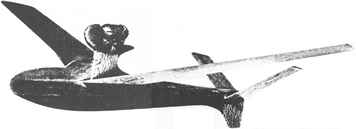
- Air Trails, June 1950 (p. 58)
|
Rudolph is the first plan published in the United States for a
Jetex 50-powered model. Air Trails, which had published the
first US Jetex design ever,
offered its readers this plan less than a year after
Wilmot Mansour had introduced the Jetex 50, and just six months after
American Telasco became the official US distributor for Jetex. Aubrey Kochmann designed this simple all-balsa model to demonstrate the capabilities of the new, smaller motor. His article gives a detailed explanation of the principle of Jetex motive power, for the benefit of a readership still largely unfamiliar with it. |
||||
|
|
|
||||
|
|
|||||
|
Pfupf
by P. Maillard (1951)
Click image to view or download large dimensioned plan and building and flying hints from Graham Knight 
- Le Modèle Réduit d'Avion (1951)
|
Taking the lead in promoting the Jetex cause in France was the premier French aeromodelling magazine,
Le Modèle Réduit d'Avion. Typical of the Jetex plans it published was the
little Pfufp, appearing in a 1951 issue. Our copy of the plan was republished in Vic Smeed's Flying Models – Favourites of the Fifties. More recently, Pfufp has been adapted for Rapier power by Grahan Knight, and we also have Graham's redrawing of the plan available for download. |
||||
|
|
|
||||
|
|
|||||
|
Supersonic Wing
by Frank Ehling (1951)
Click image to view or download large dimensioned plan 
- Air Trails, June 1951 (p. 49)
|
“Despite its simplicity and ease of construction (the complete model is made from |
||||
|
|
|
||||
|
|
|||||
|
Hawker Hunter
by Bill Dean (1952)
Click image to view or download large dimensioned plan and building and flying hints from Bill Dean 
- Eagle Annual 3,
1952
|
Bill Dean tempted Eagle Annual readers with this “flying model of the famous Hawker Hunter [that] takes just a single evening to build.” As for flying, Bill advised his young readers to “choose a space clear of trees and buildings as the model is capable of long duration flights of up to a quarter of a mile.” |
||||
|
|
|
||||
|
|
|||||
|
Arrow 50
by Ian Dowsett (1953)
Click image to view or download large dimensioned plan and building and flying hints from Ian Dowsett 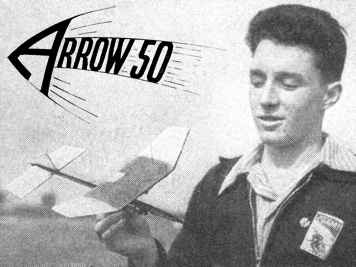
- Aeromodeller,
Apr. 1953 (p. 218)
|
One of the best – if not the best – of the classic Jetex 50 designs. Designed by the redoutable Ian Dowsett (seen in the photograph holding the prototype), the plan was published in the April 1953 issue of Aeromodeller. Highly recommended! |
||||
|
|
|
||||
|
|
|
|||
|
Puk
by Jean-Claude Aggéry (1953)
Click image to view or download large dimensioned plan and building and flying hints from Jean-Claude Aggéry 
- Le Modèle Réduit d'Avion,
May 1953 (p. 9)
|
One of a number of early Jetex 50 designs from an enthusiastic group of French designers, the quirkily named Puk is, in the words of its designer, "simplicity itself to construct and flies beautifully (even if rather acrobatically)". |
|||
|
|
|
|||
|
|
||||
|
Ukkie
by C R de Vries (1953)
Click image to view or download large dimensioned plan and building and flying hints from C R de Vries 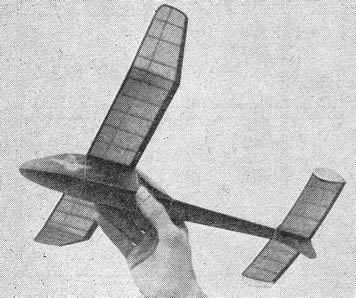
- Aeromodeller,
June 1953 (p. 347)
|
A top member of the Dutch Wakefield team, Claude de Vries designed his aptly named Ukkie (it means “infant” or “little one”) for the Jetex 50. At the 1952 Swedish Wakefield Trials, the eye of Aeromodeller's editor was taken by the “nifty flying” of this little model, which de Vries had brought with for a little light relief from the serious business of Wakefield competition. The outcome was the appearance of the plan for Ukkie in the magazine in the following year. Featuring a nose intake orifice, Ukkie's very simple construction makes it a good introduction to Jetex (or Rapier!) flying. Such was the favourable reception given to Ukkie that Claude de Vries made a further appearance with a Jetex-powered model, in the 1953 Aeromodeller Annual. His design on this occasion was particularly innovative, being for a pair of twin motor powered flying wheels, one for Jetex 50s and the other for Jetex 100s. |
|||
|
|
|
|||
|
|
||||
|
Mosca
by R. Parlatoré (1953)
Click image to view or download large dimensioned plan and building and flying hints from M. Parlatoré 
- Le Modèle Réduit d'Avion,
October 1953 (p. 8)
|
Another of the number of early Jetex 50 designs from an enthusiastic group of French designers, Mosca shows typical Gallic flair in its swept-back gull-wing, twin-tail design. Its designer describes it as having a "rather supersonic appearance". |
|||
|
|
|
|||
|
|
||||
|
Skyray
by Bill Dean (1954)
Click image to view or download large dimensioned plan and building and flying hints from Bill Dean 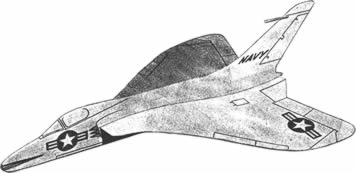
- RAF Flying Review,
Sep. 1954 (p. 51)
|
Bill Dean claimed of his scale profile F-4D Skyray that it was “based on authentic factory data”. “[Its] design is ultra-stable – as good as any conventional design and stall recovery much, much better. It’s just too easy to get this all-sheet Skyray airborne”, he said. Like its scale profile British companion Midge below, its building time was given as “just 2-3 hours”. |
|||
|
|
|
|||
|
|
||||
|
Midge
by Bill Dean (1955)
Click image to view or download large dimensioned plan and building and flying hints from Bill Dean 
- RAF Flying Review,
Feb. 1955 (p. 37)
|
Bill Dean said of his It features a cambered type wing and a catapult launching method, which “enables altitude to be gained while the jet-thrust is actually building up”. Building time is just 2-3 hours. |
|||
|
|
|
|||
|
|
||||
|
Fizzle-bug
by Ian Dowsett (1955)
Click image to view or download large dimensioned plan and building and flying hints from Ian Dowsett 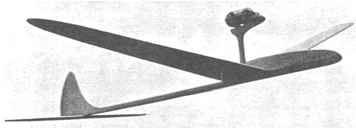
- Model Aircraft,
Mar. 1955 (p. 104)
|
Fizzle-bug, another Ian Dowsett design, is a simple all-sheet model with a very high pylon-mounted motor. Of his first design to be published by Model Aircraft, Ian had this to say: "Although of functional outline, Fizzle-bug is a high performance contest model. Building is straightforward." |
|||
|
|
|
|||
|
|
||||
|
Super Mystère
from Modèle Magazine (1955)
Click image to view or download enlarged dimensioned plan and building and flying hints 
- Modèle Magazine,
June 1955
|
This French plan for a Super Mystère was published in a special issue of Modèle Magazine in June 1955, devoted to jet aircraft. The editorial, which began by claiming “The jet pilot is the superman of our age”, said, “We'd like to give youngsters the opportunity to gain a foothold in the world of jets by making true jet powered models, which fly just like their full-size counterparts. By doing this, we hope we can arouse in today’s readers a desire to join the ranks of the supermen of tomorrow.” |
|||
|
|
|
|||
|
|
||||
|
Fizzle Quick
by Ian Dowsett (1955)
Click image to view or download large dimensioned plan and building and flying hints from Ian Dowsett 
- Aeromodeller,
Aug. 1955 (p. 408)
|
Our third Ian Dowsett design for the Jetex 50, The writer of the accompanying article said "Fizzle-Quick has a lightning acceleration which has to be seen to be believed. The answer lies in its extreme light weight, minimum construction for maximum power, and the complete reduction of fuselage wetted area to a bare minimum, comprising a simple vertical "A" frame." |
|||
|
|
|
|||
|
|
|
|||
|
|
||||
|
Vulture
by Bill Dean (1957)
Click image to view or download large dimensioned plan and building and flying hints from Bill Dean 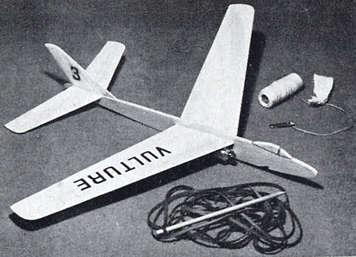
- Bill Dean's Book of Balsa Models (1957)
|
The Vulture comes from "Bill Dean's Book of Balsa Models". Bill describes it as "a graceful semi-scale fighter", with the option of a catapult launch. Brian Benson recommends "building the catapult as this extends the flight". Peter Tolhurst has these recommendations: "Heed the instructions and use medium/hard, if not hard, balsa for the fuselage. Mine wasn't hard enough, and the model was prone to snapping the fuselage either side of the wing depending on the type of 'hard' landing. Also the motor mounting plate needs to be strengthened for the Jet-X mount." |
|||
|
|
|
|||
|
|
||||
|
VTO
from American Modeler (1957)
Click image to view or download large dimensioned plan and building and flying hints from American Modeler 
- American Modeler, March 1957
|
“Model #3 in the easy-to-build, great fun-to-fly series of Air Adventurers Club model aircraft designs is this unusual "X-tail" jet fighter-like craft. Officially, it is designated Series A, Mach 3. For power it uses a real jet engine, the Jetex "35" or "50" or an equivalent solid fuel propulsion plant. “Tail fins which give the plane a rakish appearance are very easy to make and mount. All you do is cut out 4 rudder-fins. Cement two together at right angles, do same with remaining two - let the cement dry completely. Then each "V" is cemented to the fuselage rear to form an "X." Note that modeling clay is called for to balance the model for a smooth, even glide.” |
|||
|
|
|
|||
|
|
||||
|
Fizzel Fazzel
by Bob Walters (1959)
Click image to view or download dimensioned plan 
- All about Jetex,
by Paul Del Gatto (p. 20)
|
Fizzel Fazzel
is straightforward to build and is described by Mark Petrovich as a "lady of the air".
Here's the account of a "fantastic flight" Mark made in March 2003,
using a Jet-X 50 motor, which he managed to fire on his third attempt: "I was on the top of a hill about 8 feet above the field elevation. The model flew away from me and never descended. It climbed true and hesitated for a second about 50 feet away from me. It then got a second wind, pellet two no doubt, and continued climbing away. It turned a slow arc to the right and seemed to slow down a bit. Then the model lurched forwards more and I heard the mild report as the third pellet began burning. "With heart racing, I watched as the model continued to turn right and climb upwards. Progress forwards slowed a bit into the wind until the model, its fuel exhausted, settled into a glide. It had reached an estimated 40 feet above the point of launch and had executed a 360° turn with an arc radius of about 30 feet. It continued to glide until it ran into some trees about 30 feet up whereupon the wing was violently disengaged from the fuselage. The fuselage fell independently all the way to the ground and the wing tumbled through the trees to rest in some leaves. "I walked about 400 feet through mud, across an embankment and found all three parts. The fin had been torn off in the fall so I carried a total of four pieces to the car. Ecstatic, I called my son, who thinks that flying things are my drug addiction, and told him the news of this fantastic flight." |
|||
|
|
|
|||
|
|
||||
|
Fizzle XIII
by D. J. Lindley (1965)
Click image to view or download large dimensioned plan 
- Frank Zaic’s Model Aeronautic Yearbook, 1964-65, redrawn by
Carlo Godel
|
The Fizzle XIII comes from the Zaic Model Aeronautic Yearbook of 1964-65. We're indebted to Carlo Godel who has redrawn the plan especially for Jetex.org. Of his redrawn building plan, Carlo says, "It is drawn at 120 dpi for size, on a 10" x 16" format for 11" x 17" sheet". To quote the original designer, Fizzle XIII was "13th in a series of essentially identical models built since 1946 and all lost OOS before fuel was used up". |
|||
|
|
|
|||
|
|
||||
|
Good Times
by Bob Stalick (1976)
Click image to view or download large dimensioned plan (from Model Builder, Sep. 1976 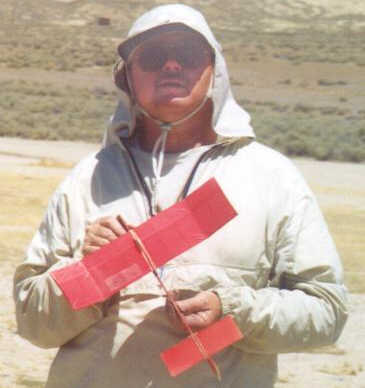
- John Riese
|
John Riese, shown here,
gives these details: "Covering is Airspan on wing, with
nitrate dope/Floquil pigment on fuse. I used basswood to frame around the
stab to keep it unwarped. The wing has washin on right center section,
washout on tips. Right rudder for a right/right pattern. I have it set up
for a pop up wing DT. Weight 22 grams empty. This plane glides busy and should thermal easily. The 'Good Times' works well with the lower powered [Rapier] L2's but is unpredictable (read that as it crashes) with an L2HP. Not a good windy weather flyer." The designer, Bob Stalick writes "Three models have been built [...] and they have all performed admirably. I don't think the D/T system shown on the plans is absolutely necessary, since the model is really easier to build than a hand launch glider, and the D/T system simply congests the model … but they do thermal since the weight is nearly nothing. "The plans are self-explanatory, but a couple of notes are in order. Be sure to include the spruce backbone on the fuselage, or else you'll be troubled with fuselage breakage. Cover the wing with tissue and apply two coats of thinned nitrate dope. Dope the entire fuselage and stab with 2 coats of nitrate. It would help to glue a piece of aluminum foil under the fuselage just behind the engine to keep this area from getting charred by the blast (?). Be sure to wash in the wing as specified. If in doubt, put in more wash in than you think it will need. Glide is controlled by excessive stab tilt to the right and climb is controlled by offsetting the rudder to the right. Engine thrust should be straight with no offsets. When ready to fly, the entire ship should weigh in at around 20 grams with motor loaded. That's about .8 ounces, and with a good Jetex burn giving out around .6 oz. of thrust, the model really hauls." |
|||
|
|
|
|||
|
|
|
|
|
|
|||
|
The following plans were all designed to meet the requirements of the PAA-Load contest, Junior Jet division. One of those requirements for the contest was that the model include a dummy pilot, hence the addition of a canopy to each of these models. |
 |
|
|
|
|
|
|
|
|
|
|
|
Acknowledgements Plan and information sources: - Midget 50: article and plan from the MAAC archives, via Bill Henderson - Rudolph: article and plan from the personal collection of Bill Henderson - Pfupf: original plan contributed by Bill Henderson; Rapier adaptation by Graham Knight - Supersonic Wing: plan from the MAAC archives, via Bill Henderson - Hunter: Article and cleaned-up plan contributed by Gareth Paterson - Arrow 50: plan contributed by Howard Metcalfe - Puk: article and plan contributed by Jean Thiry - Ukkie: article and plan from Bill Henderson; cleanup of plan and OCR of text by David Sheehy - Mosca: article and plan contributed by Jean Thiry - Small Wonder: plan contributed by Bill Henderson; notes by Keith Payne - Midge: article and cleaned-up plan contributed by Gareth Paterson - Fizzle-bug: article and plan from the MAAC archives, via Bill Henderson - Super Mystère: plan and magazine excerpt contributed by Pierre Claudy - Fizzle Quick: article and plan contributed by Peter Lloyd and Bill Henderson - Fizzel Fazzel : plan and information contributed by Doug Foster - Fizzle XIII: redrawn plan contributed by Carlo Godel - Vulture: article and plan contributed by Brian Benson - VTO: article and plan contributed by Carlo Godel - Good Times: article and plan contributed by Doug Foster; photo and comments by John Riese - F-19 Stealth: article and plan from the MAAC archives, via Bill Henderson - Junior Jet Record Holder: plan contributed by Bill Henderson - Dummy Dip 50: plan contributed by Bill Henderson |
|
|
|
|
ABOUT | MOTORS | MODELS | ARCHIVE | HISTORY | STORE | FAQ | LINKS Construction and operation | Kits | Plans: Fixed Wing Aircraft | Plans: VTOL Craft - Cars - Boats |
|
|
Terms of Use
|
Queries? Corrections? Additions?
Please
contact us.
|
|